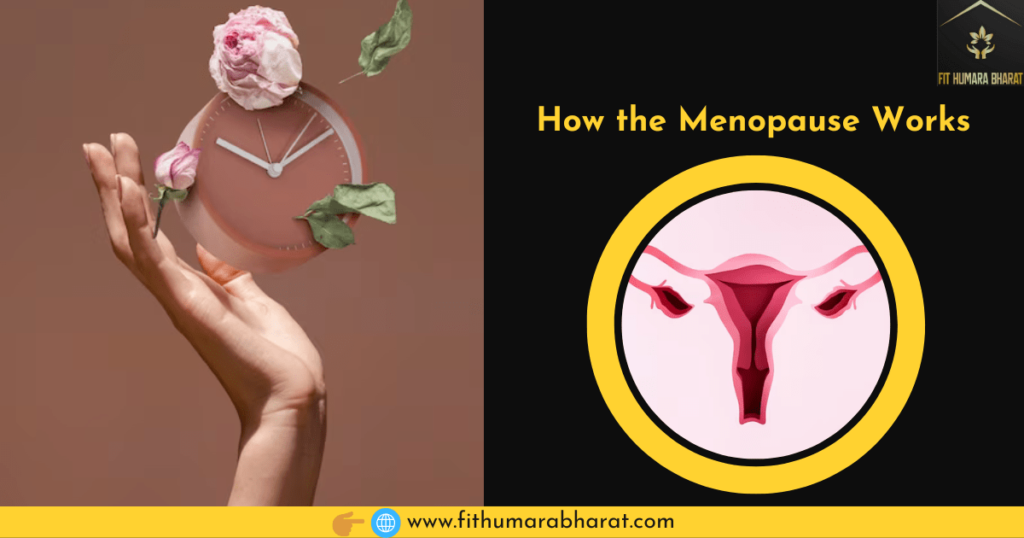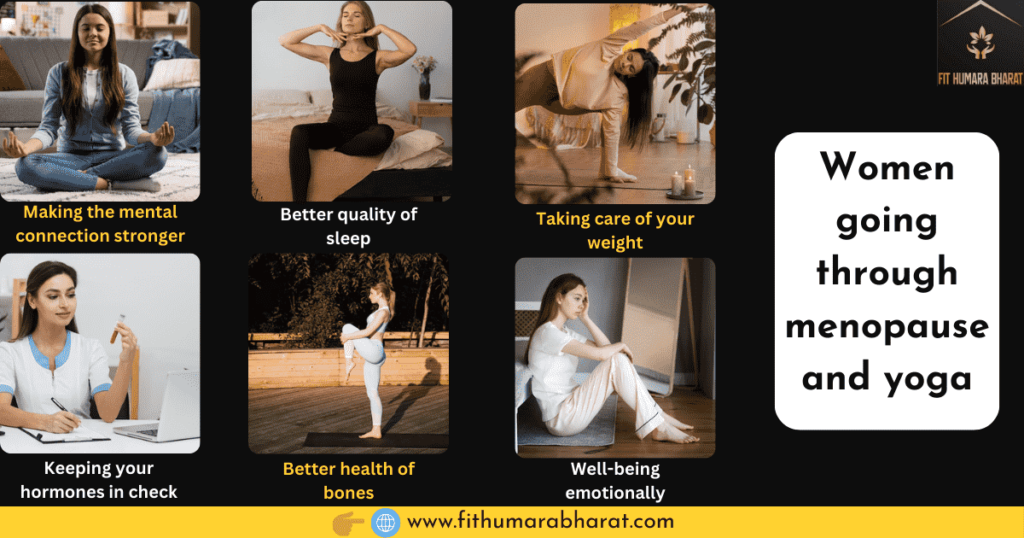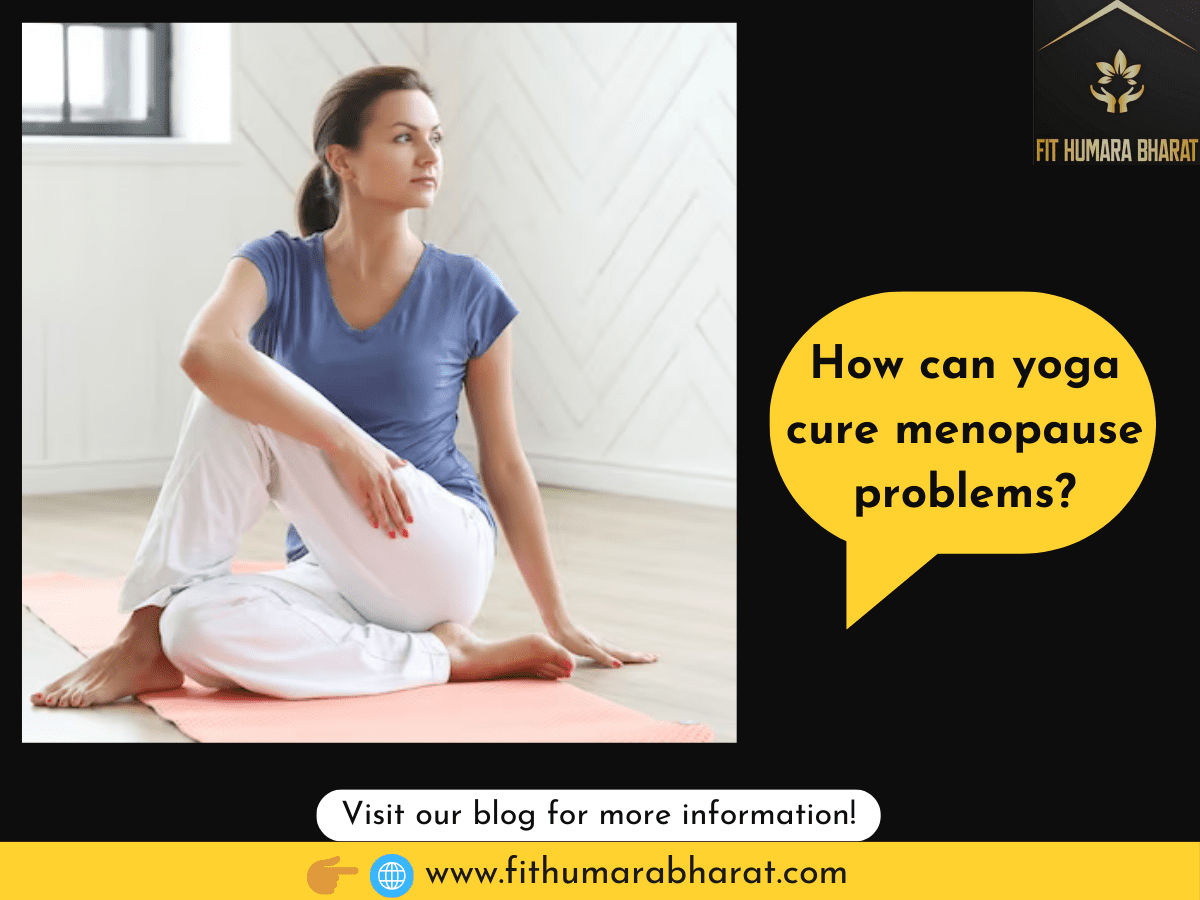A women navigate the transformative journey of menopause, they often encounter wide range of physical and emotional challenges. From hot flashes to mood swings, this natural transition can sometimes feel like a turbulent storm in their body. However, with all the challenges and problems, there exists a serene oasis: yoga!
Beyond its reputation as a physical exercise, yoga offers a holistic approach to wellness that addresses both the body and the mind. In this blog, we delve into the fascinating realm of how yoga serves as a potent remedy for the symptoms and struggles of menopause, guiding women toward a path of balance, vitality, and inner peace.
At the end you will find the list of yoga you should do during menopause
Table of Contents
How the Menopause Works:
When a woman’s ovaries stop making eggs, her amounts of androgen and progesterone decrease. The name for this is menopause. In response to this hormone change, many mental and physical changes occur, including:

- Sudden sensation of warmth spreading throughout her body.
- Often accompanied by redness and sweating in the face and neck.
- Women notices behavioral swings like sadness, anger, or nervousness.
- The state of being unable to fall or stay asleep is known as sleepiness. They feel sleepy and tired during the day because of this.
- For some it can lead to bone loss, causing osteoporosis and more frequency of bone breaking.
Symptoms that affect women’s health and daily lives can be different. Some women have these symptoms for longer than others, and some women have them more severely.
Doing Yoga during menopause:
1. Making you less stressed
A big part of yoga that helps women deal with stress better is being mindful and calm. If you are stressed during menopause, symptoms like hot flashes and mood swings may get worse. Yoga can help women calm their minds, lower stress chemicals like cortisol, and find peace inside.
2. Keeping your hormones in check
While doing yoga, movements like advanced folds, twists, and inversions can help the endocrine system work better. The endocrine system controls hormone release. You can reset the balance of estrogen and progesterone by doing these movements. Feelings like hot flashes and mood swings might lessen with this. Do yoga breathing techniques, like breathing through your other nostrils, to balance your sympathetic and parasympathetic nervous systems. Hormones stay balanced when this happens.
3. Better quality of sleep
Because it calms them down and focuses on rest, yoga helps women fall asleep and stay asleep. To get your body and mind ready for sleep, do some simple yoga poses, deep breathing, and silence. Early bedtime makes some people feel less tired and gives them more energy during the day.
4. Better health of bones
Yoga poses that put your weight on one leg, like standing poses and gentle backbends, are better for people with strong bones. Women are more likely to get osteoporosis as they age because of changes in hormones that happen during menopause. Women who do yoga daily can keep their bones healthy and lower their risk of losing bone strength.
5. Taking care of your weight
Since yoga helps you lose weight by making you fit, focused, and more, it’s a way to lose weight. If girls and women going through or after menopause do yoga regularly, it may help them keep a healthy weight. It can make them more aware of their bodies, speed up their metabolism, and help them build lean muscle mass.
6. Well-being emotionally
Period women might feel sad, angry, or like they’ve lost someone close to them. It is safe for women to explore and work through these feelings in yoga. Yoga can help women feel better about life and their mental health. It might help them be more robust, more understanding, and more kind to themselves.

Practical advice for doing Yoga during Menopause:
1. Begin slowly
You should start with easy, beginner-friendly classes or online videos if you are new to yoga or have symptoms linked to menopause. Always pay attention to your body and change the poses if you need to to feel comfortable.
2. Pay attention to your breath
Pay attention to your breath while you do yoga for better rest and less worry. Deep, mindful breathing can help. You can improve your calm and inner balance by doing slow, steady breathing exercises like ujjayi breath or belly breathing.
3. Drink plenty of water
Remember to drink a lot of water before, during, and after your yoga class if you are having hot flashes or sweating. Staying fresh is suitable for your health and body warmth.
4. Do it often:
Focusing on doing yoga daily is the best way to get the most out of it during menopause. At least twice or three times a week is recommended to get the most out of yoga. Gradually add more lessons and make them longer as you get better.
5. Pay Attention to Your Body
Don’t push yourself too hard when you’re tired or feeling joint pain. Know your body’s limits and listen to it. Beyond the mat, it’s essential to take care of yourself. Readjust your body’s needs. Yoga can help balance hormones, feelings, and the body to help with all menopause symptoms. Women going through menopause can handle the challenging parts of the change better and more efficiently if they do yoga daily.
Yoga Poses that can be Practiced during Menopause
- Supported Child’s Pose (Balasana)
- Supported Reclining Bound Angle Pose (Supta Baddha Konasana)
- Supported Bridge Pose (Setu Bandhasana)
- Legs-Up-the-Wall Pose (Viparita Karani)
- Supported Corpse Pose (Savasana)
- Seated Forward Bend (Paschimottanasana)
- Standing Forward Bend (Uttanasana)
- Wide-Legged Forward Bend (Prasarita Padottanasana)
- Head-to-Knee Forward Bend (Janu Sirsasana)
- Seated Forward Bend with Legs in Butterfly Pose (Baddha Konasana)
- Happy Baby Pose (Ananda Balasana)
- Reclining Bound Angle Pose (Supta Baddha Konasana)
- Wide-Legged Forward Bend (Prasarita Padottanasana)
- Cow Face Pose (Gomukhasana)
- Bound Angle Pose (Baddha Konasana)
- Pigeon Pose (Eka Pada Rajakapotasana)
- A slow-paced style of yoga that involves holding passive poses for an extended period, typically ranging from 1 to 5 minutes or more.
- It targets the deep connective tissues of the body, such as the fascia, ligaments, and joints, rather than focusing primarily on muscular engagement.
- The poses is typically performed seated or lying down, and props such as blankets, bolsters, and blocks may be used to support the body and enhance comfort.
A slow and gentle flow of yoga poses can help to improve circulation, reduce stiffness, and increase flexibility without putting too much strain on the body. Remember that yoga won’t help you right away. You can learn more about yourself and take better care of yourself on this road. The practice will help you feel better during the changes that come with menopause.
Thank You 🙏
- Effectiveness of Yoga for Menopausal Symptoms: A Systematic Review and Meta-Analysis of Randomized Controlled Trials
- Yoga for menopausal symptoms-A systematic review and meta-analysis
- Effects of yoga on menopausal symptoms and sleep quality across menopause statuses: A randomized controlled trial
- Hatha Yoga practice decreases menopause symptoms and improves quality of life: A randomized controlled trial
- Effect of yoga therapy on physical and psychological quality of life of perimenopausal women in selected coastal areas of Karnataka, India

